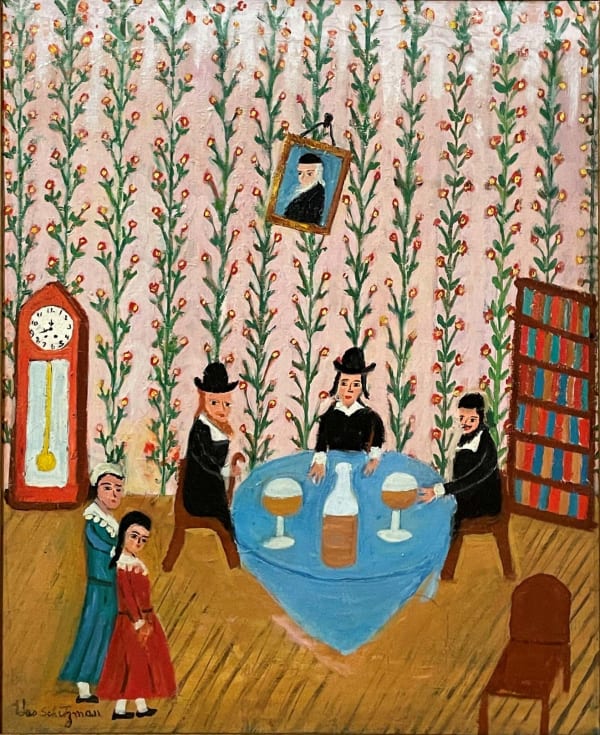Leo (Kyle) Schutzman (1878-1962) developed a reputation in New York in the 1950s as the ‘Jewish Grandma Moses.’ The characterization was particularly appropriate. Both artists only took up painting in a serious way in their old age after retiring from work. They also shared a popular aesthetic style then known as ‘primitivism’ or ‘naive art,’ far from the abstract expressionism that was the art critic’s darling at the time.
Schutzman was born Leo Kyle in Russia around 1878. His father died when he was 3 years old and he immigrated to England in his teens, where he remained for 9 years. When he moved to the United States in 1905, he took the name Schutzman after a German family who was renting to his nephew, Louis Kyle.
In New York City, Schutzman worked in the Jewish-dominated clothing industry, producing underwear as well as lace and embroidery. He founded the Victory Undergarment Company and the business was successful enough to provide for his family until he retired at about age 74.
After retirement, Schutzman took art courses at the Brooklyn Museum and began painting. He often depicted scenes of Jewish religious life that he remembered from childhood in Russia. His work seemed the very definition of ‘naive art’ as it was personified by Grandma Moses in the 1950s. His clumsy human figures sometimes had no features at all, or were portrayed with just a slash for the mouth and two dots for the eyes. He had only the vaguest sense of perspective and often used dissonant colors in unusual places.
Schutzman had his first one-man show in 1958, when he was 80 years old, at The Contemporaries gallery (992 Madison Ave.). His optimistic primitivism was popular in the United States in the 1950s as was his backstory; an immigrant who had succeeded as an entrepreneur in the capitalist system before affirming the democratic individualist creed that everyone had talents and could accomplish something at any age. He was soon socializing at parties with people like heiress/artist Gloria Vanderbilt. One of his ‘non-Jewish’ works depicting a winter carnival was chosen in 1962 for the United Nations Children’s Fund Christmas Card Collection.
When Grandma Moses died in 1961, naive art began to lose popularity Schutzman was living in Glendale Queens when he died at age 83 in 1962 and his reputation soon disappeared. In 1986, two of his paintings were acquired by the Jewish Museum in New York City. One of them, “The Wedding,” (c. 1960) was an iconic portrait of an Ashkenazic wedding. It has been reproduced by the Jewish Museum on popular stationery, and has appeared in popular books such as The Complete Idiot's Guide to Understanding Judaism.
Schutzman had three children, one of whom, Steven Kyle (1913-1979; nee Siegfried Schutzman)), married Betty Comden (1917-2006) in 1942. Comden, along with her writing partner Adolph Green, was the award-winning lyricist of many memorable Broadway and film musicals of the mid-1900s including “Singin’ in the Rain,” “On the Town,” “Peter Pan,” and “The Bandwagon.”
Leo Schutzman never minded the comparisons to Grandma Moses. He actually visited her in 1953 to show her some of his works and receive some advice from the 93-year-old painter. Both artists were noted for expunging the grim realities of life, choosing instead to focus on simple and generally joyful scenes. Schutzman once summed up his philosophy: “It doesn’t make any difference to me what they call my style as long as people enjoy the paintings.”

